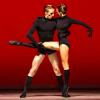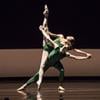
The Chicago-based Joffrey Ballet’s weekend run (March 7–8) at Zellerbach Hall, presented by Cal Performances, gave its fans an unusually brilliant show.

Sunday afternoon’s high point in an entire mountain range of them was Nicolas Blanc’s Beyond the Shore. Blanc, from France, was a principal dancer at the San Francisco Ballet from 2003 to 2009. While he was there, he choreographed two works for SF Ballet School trainees. He left to become ballet master at the Scottish Ballet, and since 2011 has held the same position at the Joffrey, where another San Francisco Ballet alum, Ashley Wheater, is visibly doing a knockout job as artistic director. Blanc’s Evenfall had its U.S. debut in 2015 during the Joffrey’s spring season.
I mention all this as someone who feels as if she gets around, when in truth, I never saw him dance (possibly because he was grappling with injuries, though in 2010 he and Tina le Blanc shared an Isadora Duncan Dance Award nomination), and never saw anything he created. The lesson, my friends, is to go out and see everything you possibly can, because you never know where the next big find is coming from.
Cocommissioned with Cal Performances, Beyond the Shore, which had its world premiere in Chicago in 2018, fills that bill and then some, or I’ll eat my tutu.
It’s in six movements, with music from one composer, Mason Bates, The B-Sides, as well as a soundscape Bates also designed. In Blanc’s words, each movement leads us to another world, another environment. You can see how tricky creating a unified work with all this universe-hopping might be. But it’s not, because Blanc keeps faith in his fantasy. The reality — the work it takes to look so otherworldly — is carefully masked by the dancers’ projection of ease and (of course) grace.

The opening section, “Broom of the System,” is a dark sweep of mystery, its backdrop dimly suggesting a map, with Yoshihisa Arai lifting April Daly in a big airborne arabesque, then helping to slide her across the ground. They’re followed by five more couples, supple yet sharp, bodies following the ticking of a clock, a flurry (or so it seemed) of lifts leading to one image, sharp and sudden, the ballerina inverted, one leg pointing outward, a stunning surprise. That technical force gives way to a duet, “Aerosol Medley (Hanalei)” with its saronglike, aqua-toned costumes and pervasive tropical delight. It’s mellow and swoopy, with Christine Rocas seamlessly floating up, up into Evan Boersma’s lifts and a gentle, beachy intimacy that peaks as both collapse, delighted, into each others’ arms.
“Gemini in the Solar Wind” blows in with major changes; we’re back to the mystery of the unknown, and now the maps might stand for lunar seas or Martian canals, or a view of Earth from the stratosphere. Victoria Jaiani and Dylan Gutierrez are the brave adventurers; she rides in astride his shoulders in a short black tutu, and they’re off to the races. The sound of static gradually becomes subtly clearer, and we hear voices that could pass for Gemini astronauts on extravehicular activity, or EVA; it’s not from NASA, but it could be. “This is the greatest experience,” raves one voice, and another repeats “come back in,” over and over.
Meanwhile, the couple is exploring too. Gutierrez lifts Jaiani, whose hands shield her ears and face, making her an instrument, sharp and probing. He points her like a radar, aiming her into the future; together, they seem to float slightly above the stage, he gliding as he lifts her high like a lunar explorer. The dance ends on another of those stunningly improbable lifts that make a virtue of stillness. After the blithe section called “Temescal Noir,” the concluding “Warehouse Medicine” brings back Jaiani and Gutierrez with the rest of the couples as the tempos rise and percussion, first hinted at in playful swats of the hands, grows to include plenty of drums and brass. Now the backdrop is a blueprint, as if all the visions of choreographer and composer have triumphally come true — thanks, of course, to the dancers; Katrin Schnabl’s costumes (especially the unisex, shiny black turtleneck leotards), and Mark Stanley’s set and lighting design.

But wait, there was more! There was, for instance, Justin Peck’s 2017 hit, The Times Are Racing, which he created for the New York City Ballet, a gorgeous, magnificently rhythmic and playful thing, with a huge cast in hip streetwear and sneakers. Even the perfect tap-dance riffs of the buoyant Dara Holmes and Derrick Agnolettti sounded crisp — and looked awesome. The music consisted of selections from Dan Deacon’s America, plus some obscure (to this listener) Beatles compositions emanating from the dimness. Aside from the witty and fluent ensemble work, a men’s pas de deux, stunningly danced by Xavier Núñez and Stefan Goncalvez, was proof, if any more is needed, that love is love is love is dance is dance is dance. It was a marvel of tenderness and gentle humor, grace and athleticism, and it would have been fine if it just went on and on.

Christopher Wheeldon’s Commedia and Stephanie Martinez’s Bliss! the opening ballets, were paired together for a special event, to music from Igor Stravinsky’s Pulcinella Suite, premiered with the Chicago Symphony at its Symphony Center last May.
Fast and fluent, Commedia was charming, if a little trite, in its humorous evocation of Pulcinella, commedia dell’arte and all that, cutely augmented by finger snaps, bonhomie, and friendly, flirty Balanchineian chains.
Stephanie Martinez’s Bliss! — an ebullient ballet by a rising Chicago dance maker — was notable for its adventurous partnering, particularly the daredevil lifts and flights of spangle-skirted women, replete with cartwheels and flips that seemed to owe as much to gymnastics as to ballet. Moving from one attraction to the next, Bliss! felt like a walk through a circus — definitely Pulcinella-esque — and ending with mock-combative chest popping from the men and plenty of supportive shouting from the cast at large. Among the many fine dancers for both ballets were Yuka Iwai, Gayeon Jung, Brooke Linford, Yoshihisa Arai, Yumi Kanazawa, and Graham Maverick.
Correction: Due to late-arriving information from the Joffrey Ballet, the names of the dancers in the men's pas de deux of The Times Are Racing have been corrected.




